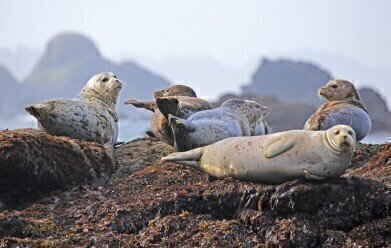Environmental Laboratory
Seals Collect Arctic Data to Predict Rising Sea Levels
Aug 22 2015
Rising sea levels are a threat to many coastal towns and cities around the world, including powerhouses such as New York and Abu Dhabi. Husband and wife oceanography team David and Denise Holland have been analysing the glaciers and fjords around Greenland in the Arctic Ocean for the past three years in a collaboration between the two aforementioned cities at the Center for Global Sea Level Change (CSLC).
In order to create computer model simulations of the potential future of our climate and of the effects that this could have on the human population vis-à-vis rising sea levels, the Hollands must collect data from remote and hostile places. The Arctic Circle is an important source of information, since mapping out how quickly the glaciers and fjords in this area will melt is key to understanding the future of our planet.
How do the team go about recovering such difficult information? By enlisting the help of the local seal population, of course.
The Dirty Half Dozen
Every year, David and his wife tag six seals at random off the shores of Nuuk, Greenland. Once caught, these seals are restrained in a net and then affixed with a small sensor weighing around 500g using epoxy glue. The glue takes roughly ten minutes to set, at which point the seal is released back into the wild. The whole process is minimally invasive and fully complies with animal welfare standards.
Since seals typically dive to depths of 200m (and sometimes as far as 600m!), they are capable of retrieving much more extensive data than humans are. The sensor itself measures the depths to which the seal dives, the temperature of the water around it and the salinity of the liquid. Every time it resurfaces, a signal is sent to the Hollands’ database in Manhattan, where they analyse the information and map out circulatory currents around the fjords. This allows them to better predict if and when more ice is due to fall into the ocean and raise sea levels around the world.
The sensor is powered by a small battery which lasts one year – at this point, the seal will more than likely be moulting its fur anyway, and the glued sensor will be discarded with it, leaving the seal free to enjoy its early retirement.
Invaluable Information
The data retrieved by the seals allows Holland and his wife to spot trends in rising or cooling temperatures in the surrounding waters and map out future predictions. Ultimately, this information could prove vital in predicting and perhaps even preventing the rising sea levels around the world which could submerge the homes of up to 650 million people by the close of the century.
As well as shedding light on the dangers of rising sea levels, Arctic water data can also prove useful to learning more about water quality and the conditions required for marine life to thrive. The article Water Quality Research in the Arctic talks in more detail about how a team from the University of Brighton are comparing information found in the northern regions of the world to pristine river samples in the UK to discover more about life on our planet. Perhaps they could use a fleet of seals of their own, too.
Digital Edition
IET 34.2 March 2024
April 2024
Gas Detection - Biogas batch fermentation system for laboratory use with automatic gas analysis in real time Water/Wastewater - Upcycling sensors for sustainable nature management - Prist...
View all digital editions
Events
Apr 22 2024 Hannover, Germany
Apr 22 2024 Marrakech, Morroco
Apr 23 2024 Kuala Lumpur, Malaysia
Apr 23 2024 Kintex, South Korea
Apr 23 2024 Edmonton, AB, Canada


















